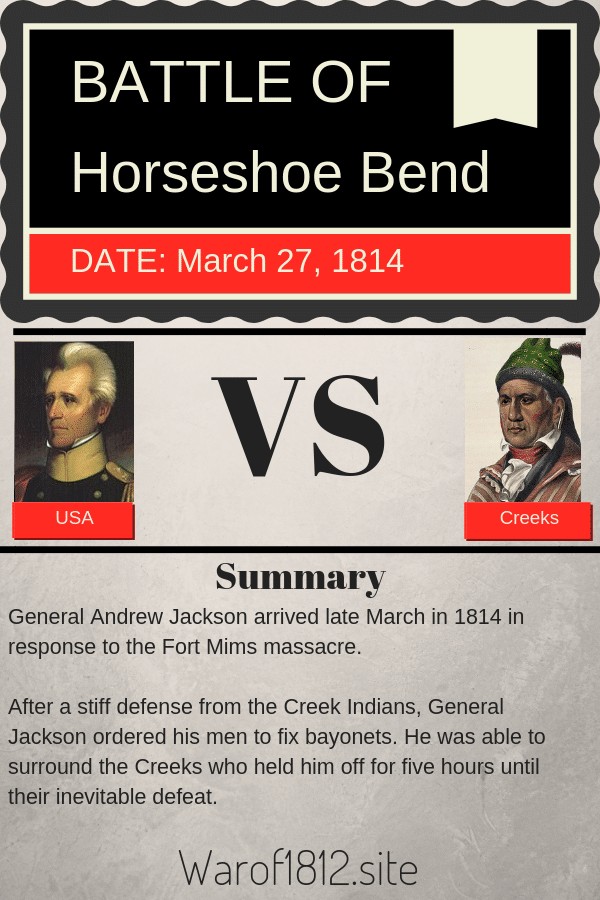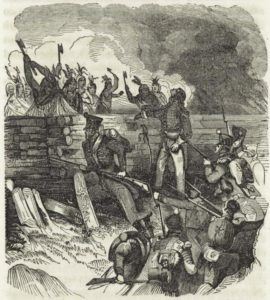The Battle of Horseshoe Bend was fought on March 27, 1814, during the War of 1812. The United States forces were led by Andrew Jackson, and they fought a Creek Indian tribe, the Red Sticks.

The Creeks were defeated, and Andrew Jackson became a national hero throughout the United States.
Prelude to the Battle of Horseshoe Bend

The Creek Indians were divided into the Upper Creeks and the Lower Creeks:
Upper Creeks: These were considered the "Red Sticks." These Creeks resisted the encroachment of American expansion and sided with the British during the War of 1812. Tecumseh also recruited them to join his alliance.
Lower Creeks: These were the Creeks that assimilated into the culture of the United States. They wished to keep that relationship with the USA, so they did not side with the British during the War of 1812.
In 1813, militia troops intercepted a Red Stick party returning from obtaining arms in Spanish Florida. While they were looting the material, the Red Sticks returned and defeated them at what became known as the Battle of Burnt Corn. Red Sticks' raiding of enemy settlements continued, and in August 1813, they attacked an American outpost at Fort Mims.
The attack on Fort Mims resulted in a massacre and caused the settlers to appeal to the Federal government. Since Federal military forces were committed to waging the War of 1812 against Great Britain, the governments of Tennessee, Georgia, and the Mississippi Territory organized militia forces, which, together with Lower Creek and Cherokee allies, fought against the Red Sticks.
General Andrew Jackson arrived with the militia at Horseshoe Bend in late March of 1814.
The Fighting

General Andrew Jackson led his American soldiers and 600 Indian allies up to a steep hill near Tehopeka. He believed he would be able to begin his attack on the Red Stick fortifications here.
He split his troops and sent approximately 1300 men to cross the Tallapoosa River and surround the Creek village.
At 10:30 a.m., Jackson began an artillery barrage on the Creeks that did little damage to them.
With his barrage ineffective, he ordered his men to fix bayonets.
He ordered Sam Houston to lead the charge on one wing while John Coffee had successfully encircled the Creek encampment.
With the Creeks now surrounded and refusing to surrender, he ordered the attack.
The Creeks fought bravely and ended up losing approximately 800 - 1,000 men, while Jackson suffered fewer than 50 losses. Indian leader Menawa was critically wounded but survived the battle.
Aftermath
The loss devastated the Creek Indians and the Red Sticks.
On August 9, 1814, Andrew Jackson forced the Creek to sign the Treaty of Fort Jackson. The Creek Nation was forced to cede 23 million acres, half of central Alabama and part of southern Georgia, to the United States government; this included the territory of the Lower Creek, which had been allies of the United States.
Jackson had determined the areas from his sense of security needs. Of the 23 million acres, Jackson forced the Creek to cede 1.9 million acres, which was claimed by the Cherokee Nation, which had also allied with the United States.
Jackson was promoted to Major General after getting agreement to the treaty.
